| |
| Acupressure - Is one of the most ancient techniques used in
the world of medicine and health as a healing therapy. It is a science
which can achieve results. Acupressure methods are known to relieve
people from stress or any kind of pains in the body. |
|
Press This Point for 45 Seconds |
| If you are among those who suffer from frequent headaches, panic
attacks, lethargy or stress attacks, this method is effective. If you
don’t have these problems, you can still go ahead and press this point –
it is considered beneficial for spiritual and emotional imbalances as
well. When doing this acupressure therapy, you must know that the
point should be pressed with moderate pressure. For best results, you
should take slow, deep breaths as you hold the point. |
 |
The Point is the Area Between the Eyebrows on the
Forehead
All you have to do is find the under bulge between the
two eyebrows on the forehead and press it for 45 seconds.
The Third Eye - Has the power to reduce muscle
tension, to improve circulation and to stimulate the brain chemicals
called endorphins.
The Third Eye acupressure point is considered to calm your mind,
relieving stress, improving memory, chronic fatigue, eye strain,
headaches, and insomnia. It also helps relieve sinus pain and
congestion. The stress relief is one of the key features of this point.
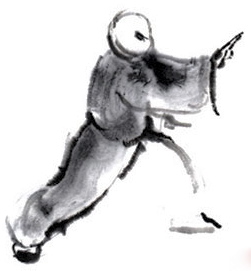 |
|
Battlefield Acupuncture Fights Pain |
|
ROBINS AIR FORCE BASE, Ga. -- When it comes to pain
relief, sharp objects aren't often the remedy most consider first.
But with the realized benefits of battlefield acupuncture, that
perception is quickly changing, one pin prick at a time. |
|
The 78th Medical Group practice
Auricular Therapy Acupuncture points to learn the acupuncture points.
The human ear has many points that relieve headaches and muscle pains
all over the body. |
Physicians and other health care providers from the 78th Medical
Group attended a training session at the Robins Medical Center as part
of an effort to get personnel acquainted with, and ultimately
credentialed on, the practice which could soon become an alleviating
addition to the base clinic.
To many, acupuncture is thought of as an intricate process involving
longer needles inserted into parts throughout the body. Battlefield
acupuncture, widely considered pain-free, is an oracular therapy
specific to the surface of the ear and consists of five small needles,
which remain in place for two to four days before they are removed or
fall out on their own; though performed in minutes, results of the
procedure are often felt within seconds.
Piazza pointed out how important these distinct locations in the ear are
in relation to pain affecting various regions of the body. "We're not
training people to be acupuncturists, we're training them for this one
particular technique," said Piazza. "And, we've found that about 80 to
86 percent of patients respond, and some of those are truly dramatic
responses."
Formerly assigned to special operations, Dougherty was embedded in work
where potentially mind-numbing narcotics and critical duties couldn't
mix. "Some can no longer control or fly because of those medications,"
he said. "So we looked for ways we could treat their pain without taking
them off status and acupuncture was one. If it works and this keeps an
airman from taking one less pill a day, that's a victory for us."
Staff Sgt. Tabitha Loomis, 78th Medical Group medical technician, had
been suffering chronic pain due to a dislocated collarbone. "This was my
first time, and I was completely skeptical," said Loomis, who
volunteered for battlefield acupuncture at the event. "And, I haven't
been this pain-free without medication in years. I'm a believer." |
|
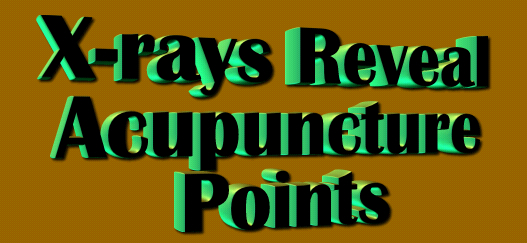 |
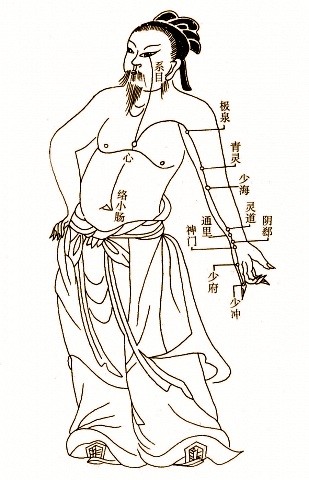 |
|
This and other Incredible
Acupuncture Research marks the start of the "Year of the Horse"
Additionally, new research confirms that acupuncture is effective for
the treatment of depression, anxiety and hypertension.
Moreover, the anti-inflammatory effects of acupuncture can avert sepsis
and save lives. |
Scholars were amazed at the new CT (computerized tomography) scans
of acupuncture points. The CT X-rays, published in the Journal of
Electron Spectroscopy and Related Phenomena, reveal clear distinctions
between non-acupuncture point and acupuncture point anatomical
structures. New in-line phase contrast synchrotron radiation CT
techniques reveal that acupuncture points have a uniquely high density
of micro-vessels and contain a large amount of involuted microvascular
structures that are not present in non-acupuncture points.
Acupuncture points have microvascular densities with bifurcations that
“can be clearly seen around thick blood vessels” but non-acupuncture
points show few thick blood vessels and none show fine, high density
structures found in true acupuncture points. The researchers note that
“the high brightness, wide spectrum, high collimation, polarization and
pulsed structure of synchrotron radiation” facilitated the discovery.
The research team concluded, “Our results demonstrated again the
existence of Acupoints, and also show that the Acupoints are special
points in mammals.” These findings emerged at a time when the
academic community had recently learned that acupuncture points have
higher oxygen pressure levels. Using an amperometric oxygen microsensor
to detect partial oxygen pressure variations at different locations on
the anterior aspect of the wrist, researchers discovered something
astonishing. Acupuncture points have measurable and unique oxygen
characteristics. This evidence is scientifically repeatable and the
oxygen sensor imaging exactly corresponds to all acupuncture points in
the region: LU9, LU8, LU7, PC7, PC6, HT7, HT6, HT5 and HT4.
Non-acupuncture points do not demonstrate these qualities. Additional
acupuncture continuing education research reveals important clinical
findings. The following images are the oxygen sensor images with a grid
overlay of acupuncture point locations for reference. |
|
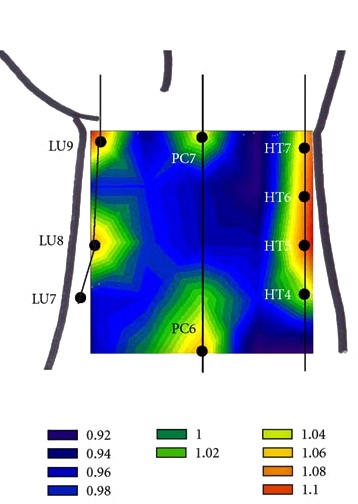
|
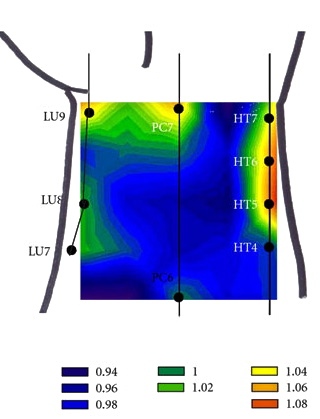
|
Acupuncture is Anti-Inflammatory
Researchers at the Department of Surgery, Rutgers New Jersey Medical
School have discovered that electroacupuncture fights infections
including polymicrobial peritonitis. In a laboratory experiment, the
researchers proved that electroacupuncture reduces severe systemic
inflammation due to infections, sepsis. The researchers discovered that
the anti-inflammatory effects of electroacupuncture “are voltage
dependent.” Non-acupuncture points (sham points) did not exert
anti-inflammatory responses. Only true acupuncture was effective in
regulating cytokine levels, preventing sepsis and boosting dopamine
levels. The anti-inflammatory mechanism of electroacupuncture is now
proven to be “mediated by the sciatic and vagus nerves that modulates
the production of catecholamines in the adrenal glands.” The Rutgers New
Jersey Medical School researchers added that there is ”growing evidence
supporting its effects in postoperative and stroke rehabilitation.”
Acupuncture Prevents Stroke
New recent demonstrates that acupuncture significantly decreases the
risk of stroke for patients with traumatic brain injuries (TBIs). In a
large scale study of 29,636 patients, researchers document that TBI
patients receiving acupuncture have a “lower probability of stroke than
those without acupuncture treatment during the follow-up period.” |
|
 |
Acupuncture For Depression & Anxiety
The success of acupuncture for the treatment of depression and anxiety
has been demonstrated in recent studies. Chuhua et al. conclude that
acupuncture is effective for the treatment of generalized anxiety
disorder (GAD) and that “a number of Meta analysis and system
evaluations point out that acupuncture treatment has more advantages
than drugs in the treatment of anxiety disorders….” |
Acupuncture Benefits The Brain
Yang et al. note that numerous studies demonstrate “that acupuncture is
an effective remedy for depression and it may be as effective as
antidepressant drugs.” They conducted a lab experiment and discovered
that electroacupuncture increases neurogenesis in the hippocampus in the
same manner as SSRI antidepressants. Neurogenesis is the process by
which neurons are generated from neural stem and progenitor cells.
Electroacupuncture “alleviated depressive-like and anxiety-like
behaviors in the rat” group, restored proliferation of ANPs (amplifying
neural progenitors) and limited cell death of QNPs (quiescent neural
progenitors). This caused a preservation of NPs (neural progenitor
cells) in the hippocampus, an important part of the brain’s limbic
system.
Acupuncture Lowers Blood Pressure
There is no shortage of hard data demonstrating that acupuncture can
reduce hypertension. The research of Shaoyang Cui et al. concludes that
acupuncture has a “stable antihypertensive effect.” They add, “Many
animal and clinical studies have reported the efficacy of acupuncture in
reducing hypertension.” This study isolated the effects of a single
acupuncture point on laboratory rats with hypertension. The researchers
conclude acupuncture at KI3 has an “antihypertensive effect for
essential hypertension.”
Researchers at the University of California, Irvine and University of
California, Los Angeles concur that acupuncture is effective in lowering
blood pressure. Their study investigated the effectiveness acupuncture
points P5, P6, LI10 and LI11 combined with electroacupuncture for the
treatment of hypertension. The researchers concluded that acupuncture
successfully reduces hypertension. The researchers discovered an
additional finding; the application of this acupuncture treatment
prescription protocol protected heart tissues and reduced arrhythmias. |
|
 |
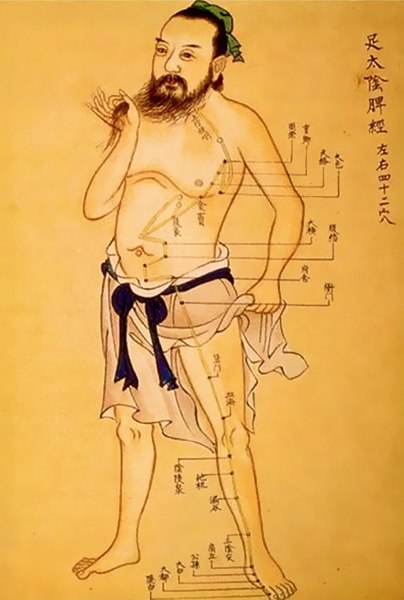 |
|
Yin Tang - Acupuncture Point
'The Hall of Impression' |
|
Though the acupuncture point Yin Tang is located
along the course of the Du Mai (Governing Vessel), it does not
officially belong to that meridian. It belongs to a category of points
known as “Extraordinary Points”. These extraordinary points stand on
their own, they are not connected to any particular meridian. |
|
In Traditional Chinese Medicine it will:
Benefit the Nose
Alleviate Pain
Calm the Shen
Shen refers to the spirit of a person. In trying
to calm the Shen, the intent is to restore calm and ease to the person
through the stimulation of this point.
The location of Yin Tang corresponds to the
Upper Tan Tian, traditionally believed to be the home of Shen,
which is one of the Three Treasures. The space of the upper
Tan Tian is also called the Crystal Palace, which is in the
center of the skull, between the two hemispheres of the brain, where the
thalamus, and hypothalamus glands reside. Though the acupuncture point
Yin Tang itself is on the surface of the skull, it is used as a portal
into the larger region of the upper Tan Tian, and hence is of utmost
importance for Qigong and Nei Gong practice. |
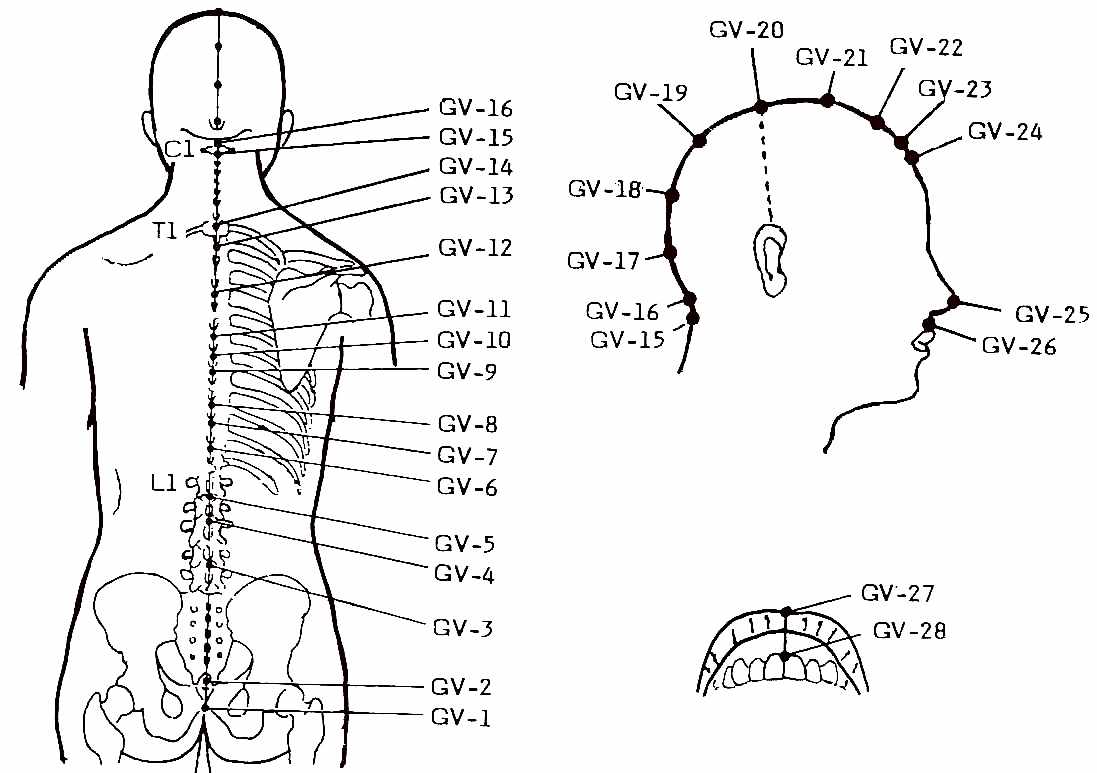 |
|
Yin Tang Point |
|
Du Mo - Governing Vessel |
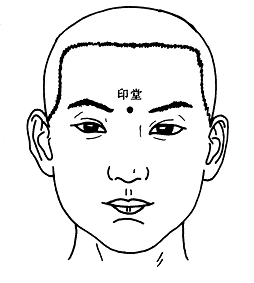 |
Yin Tang is found on the face, and is located at the Glabella - the
midpoint between the inner ends of the eyebrows. This point is often
instinctively massaged by many people in an attempt to relieve headaches
and various discomforts of the face.
Yin Tang is used in the relief of a number of health discomforts. Yin
Tang may be used alone or in combination with other acupuncture points.
Insomnia: disturbances in sleep patterns resulting from
difficulty falling asleep, staying asleep or both. Persons will often
wake in the mornings feeling unrefreshed.
Excessive Agitation, Restlessness and Irritability: This may be
caused by a number of different reasons, including: lack of good sleep,
uncomfortable environmental factors, work and family pressures or a
medical condition.
Stress & Anxiety: whether due to work, family or a variety of
life pressures. |
Pain Relief: Yin Tang is also used for headaches and facial
pain, including those related to sinus congestion and other chronic pain
syndromes. Typically, this point is used in combination with other
acupuncture points on the face and the extremities to alleviate facial
pain and headache.
Also: Yin Tang is often used as part of treatment plans to manage
hypertension and relieve dizziness.Needling (Not Recommended
unless trained in this technique)
One method of stimulating the point is with the insertion of very thin
acupuncture needles. When needled, the acupuncture needle is directed
downward with the needle lying almost flat against the skin, with a
needling depth of not more than half an inch.
Massage
Alternately, one can administer self-massage at this point, using slow
circular motions for up to five minutes. Depending on whether you are
using this point to calm the Shen, benefit the nose or relieve pain,
appropriately diluted essential oils may be massaged at the point to
enhance relief.
Oils:
Calm Shen: Chamomile, Lavender, Sandalwood, Ylang Ylang,
Frankincense.
Benefit the Nose: Eucalyptus, Marjoram, Peppermint, Thyme,
Rosemary. |
|
 |
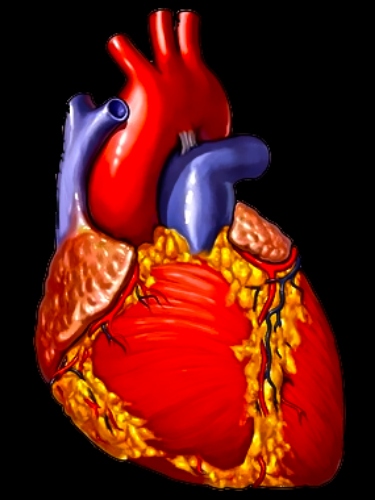 |
|
An important new acupuncture study from the
Department of Nuclear Medicine at Peking University Shenzhen Hospital
successfully measured improvements in blood flow to the heart for
patients with coronary heart disease. |
|
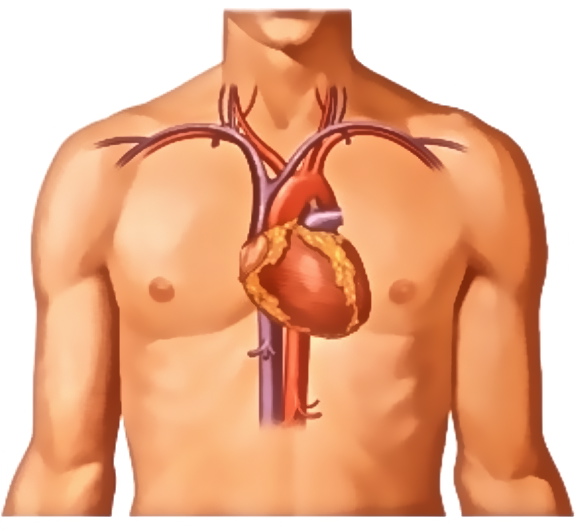 |
Coronary heart disease is due to plaque build-up in the walls of the
coronary arteries, a condition known as atherosclerosis. This build-up
can narrow the coronary arteries and lead to a decrease of oxygen rich
blood flow to the heart. Myocardial ischemia, a condition wherein blood
flow to the heart is decreased due to a blockage of the coronary
arteries, can cause damage to the heart, arrhythmias, angina or even a
heart attack. The new findings demonstrate that acupuncture has the
ability to improve blood flow to the heart.
Researchers discovered that needling two specific acupuncture points
caused significant improvements in patients with CHD. Acupuncture
successfully increased “blood perfusion of ischemic myocardium.”
The acupuncture procedure used in the study consisted of
electroacupuncture applied bilaterally to both PC6 (Neiguan) and UB15 (Xinshu).
The acupuncture needles were retained for 30 minutes with an
electroacupuncture frequency setting between 2 - 15 Hz at a strength of
9 - 18 mA. PC6 is located 2 cun, (a cun is approximately 1 inch), above
the |
| transverse crease of the wrist, between the tendons of the palmaris
longis and flexor carpi radialis. UB15 is located 1.5 cun lateral to
T-5, at the level of the lower border of the spinous process.
According to Traditional Chinese Medicine (TCM) theory, PC6 is a Luo-connecting
point and a confluent point of the Yin Wei channel. PC6 calms the heart
and shen, regulates Qi and suppresses pain. Traditional indications
include: cardiac/chest pain, palpitations, stomachache, nausea,
vomiting, hiccups, mental disorders, seizures (epilepsy). UB15 is a
heart back-Shu point. UB15 calms the heart and Shen and regulates the Qi
and blood. Traditional indications include: cardiac/chest pain, mental
disorders (panic, psychosis, loss of memory), night sweats,
spermatorrhea (including nocturnal emission).
Given the heart related historical use of the acupuncture points tested,
the point selection is congruous with the focus of the study. The
researchers concluded that both acupuncture and nitroglycerine increased
blood perfusion to ischemic myocardium in patients with coronary heart
disease. |
|

